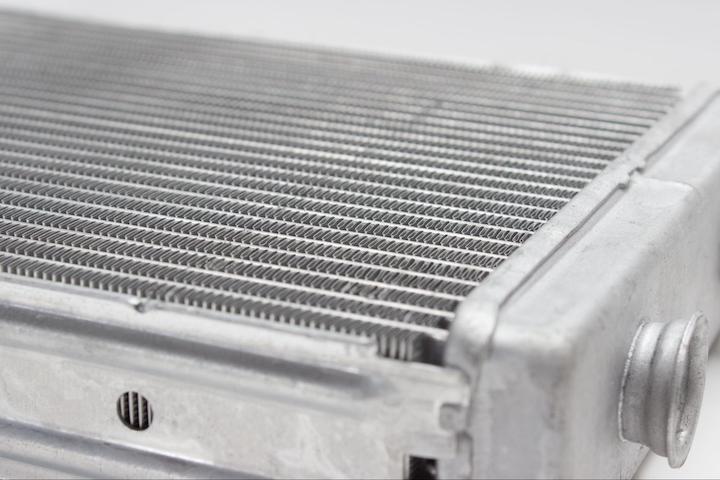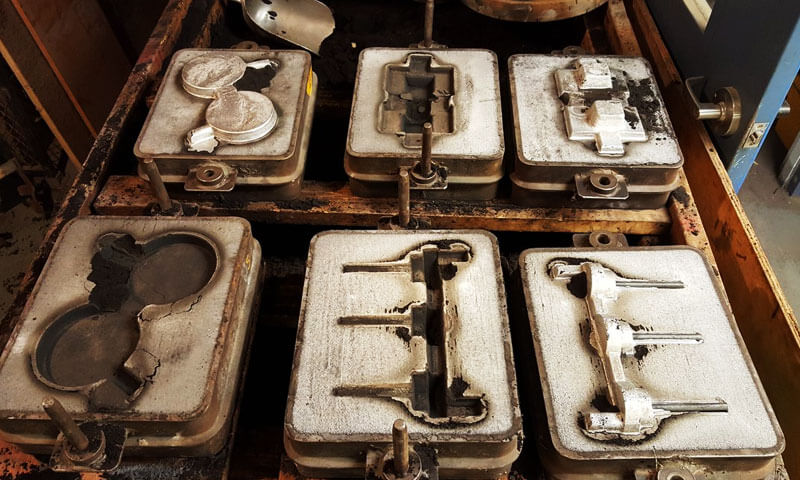Exploring the Important Applications and Utilizes of Light Weight Aluminum Foundry in Modern Manufacturing
Aluminum foundries play a necessary duty in modern-day production, offering varied sectors with their unique residential properties. From auto components that boost gas efficiency to aerospace structures that focus on weight, light weight aluminum's versatility appears. Its applications include building and construction and consumer electronic devices, highlighting its resilience and power effectiveness. The developments in aluminum spreading strategies and future patterns call for a closer evaluation, as they may redefine its effect on production.
The Role of Aluminum Foundries in Automotive Production
As the vehicle industry increasingly focuses on light-weight products to improve gas effectiveness and performance, light weight aluminum factories have actually come to be vital contributors to making processes. These foundries concentrate on creating parts that fulfill the rigid demands of modern-day cars, such as engine blocks, transmission real estates, and structural aspects. Light weight aluminum's positive properties-- such as high strength-to-weight proportion, deterioration resistance, and exceptional thermal conductivity-- make it an optimal choice for automotive applications.
Light weight aluminum foundries use advanced spreading techniques, consisting of die casting and sand spreading, to create sturdy and intricate parts. This capability permits producers to maximize designs for efficiency while decreasing weight. The use of light weight aluminum additionally supports sustainability goals, as it is highly recyclable and minimizes power intake in cars. By promoting the integration of aluminum into auto design, factories play a crucial role fit the future of the automobile market, advertising performance and technology throughout the board.
Aerospace Applications: Lightweight Solutions for Flight
Aluminum foundries play a considerable function in the aerospace market, where the need for light-weight products is paramount for enhancing fuel effectiveness and performance in aircraft. The distinct homes of aluminum, including its high strength-to-weight ratio and rust resistance, make it a suitable option for different aerospace elements. These elements include architectural components, engine cases, and landing gear, which contribute to overall airplane efficiency.
Making use of aluminum alloys, particularly those developed via innovative spreading methods, permits the production of detailed layouts and complicated shapes while minimizing weight. Additionally, aluminum's recyclability straightens with the aerospace sector's sustainability objectives, reducing ecological impact. With continual advancements in light weight aluminum shop innovations, manufacturers can enhance manufacturing processes, causing raised performance and reduced prices. As the aerospace sector increasingly focuses on developments that improve performance, light weight aluminum shops will stay indispensable to creating light-weight options for contemporary trip.
Structure and Construction: Enhancing Structural Stability
In the building and construction market, a substantial emphasis is put on improving architectural honesty via using light weight aluminum. Recognized for its high strength-to-weight proportion, light weight aluminum provides resilience without endangering on weight, which is important in modern architectural layouts. Its resistance to deterioration even more assures durability, making it an ideal product for various structural components, consisting of beams, structures, and cladding.
Light weight aluminum also helps with ingenious style possibilities, allowing designers and designers to create cosmetically pleasing frameworks while maintaining safety and security criteria. The material's flexibility enables its application in both residential and business tasks, from high-rises to bridges. In addition, innovations in aluminum foundry techniques have enhanced the precision of aluminum elements, guaranteeing they fulfill rigid building ordinance. Generally, the assimilation of light weight aluminum in building not just enhances architectural honesty however likewise adds to lasting building techniques, given its recyclability and energy-efficient production approaches.
Customer Electronic Devices: The Increase of Light Weight Aluminum in Innovation
In the domain of customer electronic devices, light weight aluminum has actually acquired prominence due to its light-weight style benefits and superior thermal conductivity. This change not just boosts product transportability however also boosts gadget efficiency by efficiently dissipating warmth. As technology remains to advance, the role of aluminum in producing smooth and efficient gadgets is significantly significant.
Lightweight Layout Benefits
As customer electronic devices progress, the need for light-weight yet sturdy materials has surged, making aluminum a progressively popular choice among manufacturers. Its reduced density enables the production of streamlined tools that are simple to lug and make use of, significantly enhancing portability. The strength-to-weight ratio of aluminum guarantees that products can stand up to everyday wear and tear without compromising performance. Furthermore, the malleability of light weight aluminum makes it possible for suppliers to make complex shapes and kinds, additionally contributing to innovative appearances and performance. This lightweight attribute additionally plays an important role in power effectiveness, as lighter gadgets call for less energy to operate. As an outcome, aluminum not just satisfies the evolving visual demands but likewise aligns with the contemporary concentrate on sustainability in consumer electronics.
Thermal Conductivity Benefits
Thermal conductivity is an essential element in the efficiency of customer electronic devices, and aluminum excels in this domain. Its high thermal conductivity enables for reliable heat dissipation, which is crucial for maintaining ideal operating temperatures in devices such as mobile phones, laptop computers, and gaming consoles. By assisting in quick heat move far from delicate parts, aluminum aids avoid overheating, consequently improving performance and extending tool durability. In addition, the lightweight nature of light weight aluminum complements its thermal residential or commercial properties, making it an ideal selection for mobile modern technology. As suppliers progressively prioritize efficiency and energy efficiency, light weight aluminum's duty in thermal management ends up being also more considerable, resulting in its expanding fostering in modern-day digital layouts. This fad underscores light weight aluminum's importance in consumer electronic devices development.
Marine Industry: Corrosion Resistance in Harsh Environments
Deterioration resistance is an essential consider the marine industry, where tools and structures are routinely exposed to harsh deep sea settings. Light weight aluminum, especially in its alloy types, provides substantial advantages in this respect. Its natural oxide layer gives a protective obstacle that protects against corrosion, making it ideal for vessels, docks, and various other marine applications.
Marine-grade light weight aluminum alloys, such as 5083 and 6061, are especially made to endure the harsh impacts of saltwater and weather. These alloys not only stand up to deterioration yet read here also maintain architectural integrity and strength over time. Applications vary from hulls and superstructures of ships to parts in offshore platforms.
The lightweight nature of aluminum more improves its viability, enabling improved gas efficiency and ease of handling - aluminum foundry. As the marine industry continues to concentrate on toughness and efficiency, light weight aluminum continues to be a crucial material option for withstanding corrosion sought after aquatic settings
Technologies in Aluminum Spreading Techniques
While typical light weight aluminum casting methods have actually served the market well, current advancements are transforming the landscape of aluminum manufacturing. Strategies such as 3D printing of molds and cores are obtaining grip, permitting rapid prototyping and reduced preparations. This advancement allows makers to create complicated geometries that were previously tough to attain with standard casting techniques. In addition, advancements in die-casting innovation, consisting of the usage of high-pressure die-casting (HPDC), have improved the accuracy and surface finish of actors aluminum parts, causing improved efficiency in different applications.
Additionally, the adoption of investment casting has allowed for higher design freedom and decreased material waste. Casting Foundry. Advancements in alloy make-ups are additionally considerable, as they enhance mechanical properties and deterioration resistance. Overall, these advancements not only streamline production processes yet likewise add to more sustainable practices within the light weight aluminum factory industry, making it versatile to the developing demands of modern production
Future Fads in Aluminum Factory Manufacturing
The future of aluminum foundry production is positioned for considerable improvement via automation, enhancing performance and accuracy in manufacturing procedures. Lasting techniques are significantly ending up being a top priority, as shops look for to reduce their ecological influence while satisfying growing governing demands. Furthermore, innovations in alloy development will make it possible for the creation of more powerful, lighter products tailored for diverse applications, driving innovation in the industry.
Automation in Shop Processes

Sustainable Production Practices
A growing focus on lasting production practices is improving the future of light weight aluminum foundry production. pop over here Sector leaders are progressively adopting energy-efficient modern technologies and reusing efforts to minimize waste and lower carbon impacts. The use of recycled light weight aluminum considerably lowers power consumption contrasted to main aluminum manufacturing, making it a preferred selection for ecologically conscious makers. Additionally, cutting-edge spreading techniques are being created to enhance product efficiency and minimize exhausts. Business are additionally purchasing renewable resource resources, such as solar and wind, to power their procedures sustainably. Casting Foundry. By incorporating these techniques, the aluminum factory sector not only meets governing requirements but likewise reacts to consumer demand for greener items, inevitably paving the method for a more lasting manufacturing landscape
Advanced Alloy Growth
Improvements in light weight aluminum alloy development are set to play a substantial duty in the future of foundry manufacturing, particularly as sustainability and performance demands intensify. The market is significantly concentrating on creating high-strength, lightweight alloys that can endure extreme conditions while minimizing environmental effect. Researchers are checking out ingenious structures, such as aluminum-lithium and aluminum-scandium alloys, which assure boosted mechanical homes and minimized weight. In addition, the combination of sophisticated production techniques, including additive manufacturing and accuracy spreading, enables even more facility geometries and minimized material waste. As regulatory pressures and consumer choices change in the direction of greener options, the advancement of energy-efficient and recyclable alloys will be vital. The future landscape of light weight aluminum shop manufacturing rests on these improvements in alloy innovation.

Frequently Asked Concerns
What Are the Environmental Impacts of Aluminum Shop Workflow?
Aluminum foundry procedures can lead to significant ecological influences, including greenhouse gas exhausts, energy intake, and waste generation. In addition, incorrect administration of toxins may lead to dirt and water contamination, influencing regional ecosystems and communities.
Exactly How Does Light Weight Aluminum Recycling Affect Foundry Processes?
Aluminum recycling boosts shop processes by offering an affordable raw see this page product, reducing power consumption and emissions. This lasting practice enhances effectiveness, minimizes waste, and supports the circular economic situation, benefiting both producers and the atmosphere.
What Security Procedures Are Applied in Light Weight Aluminum Foundries?
Light weight aluminum shops implement various safety measures, including personal protective equipment, proper air flow systems, normal safety training, fire avoidance procedures, and equipment upkeep treatments to minimize hazards and assure a risk-free workplace for all workers.
Exactly How Do Foundries Make Sure Quality Assurance in Aluminum Casting?
Factories assure quality assurance in light weight aluminum casting via extensive material evaluations, exact temperature level tracking, standard procedures, and normal testing of cast products. These procedures aid keep uniformity, reduce problems, and satisfy market specs properly.
What Are the Cost Consider Aluminum Factory Manufacturing?
Expense consider light weight aluminum factory manufacturing consist of basic material costs, energy consumption, labor expenses, devices maintenance, and overhead costs. Furthermore, production volume and complexity of layouts greatly affect general manufacturing costs and success.
As the vehicle market increasingly focuses on light-weight products to improve fuel efficiency and efficiency, aluminum factories have actually become crucial factors to manufacturing procedures. Aluminum factories play a significant duty in the aerospace market, where the demand for light-weight products is paramount for boosting fuel performance and performance in airplane. Furthermore, innovations in light weight aluminum factory techniques have boosted the accuracy of aluminum parts, ensuring they meet strict building codes. While typical aluminum spreading approaches have actually served the sector well, current technologies are changing the landscape of aluminum production. The usage of recycled aluminum significantly decreases energy consumption compared to key aluminum production, making it a favored choice for environmentally aware suppliers.